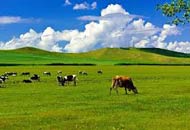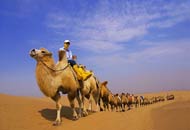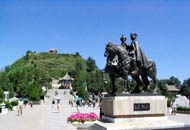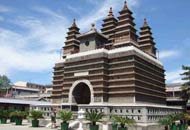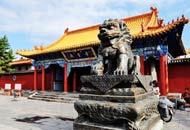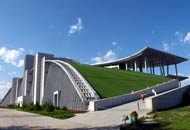 Inner Mongolia Autonomous Region (aka Inner Mongolia), which lies south of present-day Mongolia (aka Outer Mongolia), got its name because of the presence of large numbers of Monan (“Southern”) Mongols in the area at the time the region became a part of the People’s Republic of China. Before that, the territory corresponding to present-day Inner Mongolia became a part of the Republic of China after the fall of the Qing (CE 1644-1911) Dynasty (all of Mongolia had become a part of China by the close of the Qing Dynasty). But Inner Mongolia had not always been “Mongolian”.
Inner Mongolia Autonomous Region (aka Inner Mongolia), which lies south of present-day Mongolia (aka Outer Mongolia), got its name because of the presence of large numbers of Monan (“Southern”) Mongols in the area at the time the region became a part of the People’s Republic of China. Before that, the territory corresponding to present-day Inner Mongolia became a part of the Republic of China after the fall of the Qing (CE 1644-1911) Dynasty (all of Mongolia had become a part of China by the close of the Qing Dynasty). But Inner Mongolia had not always been “Mongolian”.
After Genghis Khan unified the Mongol tribes in 1206 and founded the Mongol Empire, the Tangut Western Xia empire was ultimately conquered in 1227, and the Jurchen Jin dynasty fell in 1234. In 1271, Kublai Khan, the grandson of Genghis Khan established the Yuan dynasty. Kublai Khan’s summer capital Shangdu (aka Xanadu) was located near present-day Dolonnor. During that time Ongud and Khunggirad peoples dominated the area of what is now Inner Mongolia. After the Yuan dynasty was overthrown by the Han-led Ming dynasty in 1368, the Ming captured parts of Inner Mongolia including Shangdu and Yingchang. The Ming rebuilt the Great Wall of China at its present location, which roughly follows the southern border of the modern Inner Mongolia Autonomous Region (though it deviates significantly at the Hebei-Inner Mongolia border). The Ming established the Three Guards composed of the Mongols there. Soon after the Tumu incident in 1449, when the Oirat ruler Esen taishi captured the Chinese emperor, Mongols flooded south from Outer Mongolia to Inner Mongolia. Thus from then on until 1635, Inner Mongolia was the political and cultural center of the Mongols during the Northern Yuan dynasty.
Under the Han Chinese Ming (CE 1368-1644) Dynasty, which had overthrown the Mongol Chinese Yuan Dynasty, Inner Mongolia itself was divided into two separate adminsitrative regions, Dada and Wala. “Northern” and “southern” Mongolia, corresponding to present-day Outer and Inner Mongolia, respectively, were always somewhat divided, as the Monan designation indicates, due to the presence the Gobi Desert, a natural barrier which roughly divides the two areas (it overlaps both areas), thus weakening any bond which might exist even on an ethnic basis. During the Manchu Qing Dynasty, Inner Mongolia was re-unified (the Dada and Wala administrative regions were disbanded), though the areas corresponding to present-day Inner and Outer Mongolia remained separate – both administratively and to some extent culturally – with Inner Mongolia becoming more etnically mixed than Outer Mongolia.
This tendency would only increase, such that when the Qing Dynasty fell – leaving the newly-formed Republic of China, on the one hand, and Mongolia on the other hand, to emerge from the ashes of Imperial China – the Republic of China would have its own reasons to retain that portion of Mongolia with which it had closest ties, namely, “southern” Mongolia, which, at the time, was under the administration of three separate provinces: Rehe, Chahaer, and Suiyuan (the name “Inner Mongolia” had not yet been conceived).
When the Republic of China gave way to the People’s Republic of China, the territory corresponding to “southern” Mongolia had become such an integral part of China that it was unthinkable to relinquish it, though, in response to the territory’s primary ethnic minority make-up (the Han Chinese were already the ethnic majority), it was designated as Inner Mongolia and was soon thereafter – on May 1st, 1947 – made into an autonomous region, the first such ethnic region within the PRC.
Inner Mongolia Weather
Inner Mongolia WeatherInner Mongolia is far away from ocean with a wide area and a high altitude above sea level. Hence, Inner Mongolia has a temperate monsoon climate, featured by few and irregular rainfall, drastic shift of temperature. Cold, long winters with frequent blizzards; warm, short summers; from west to east, the climate changes from arid to semi-humid, and to humid in the northeast.The climate in Hohhot is characterized by the long winter and short spring, summer and autumn. It is quiet dry, with an annual precipitation varying between 350 millimeters (13.8 inches) and 500 millimeters (19.7 inches).
Inner Mongolia Attractions
|
|
|
|
|
|
|
|
|
|


